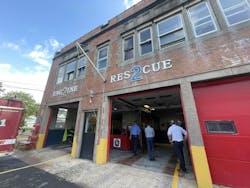Getting the Most Out of Your Fire Station Tour for Design Ideas
Key Takeaways
- Use fire station tours to identify operational pain points, gather inspiration, and assess new technologies or firehouse design features.
- Discuss and prepare detailed checklists and collaborate with fire station design professionals to ensure practical and cost-effective solutions.
- Focus on the impact of design plans and how it impacts firefighter safety, morale, and daily operations to create a fire station that truly meets a department's needs.
Embarking on a station renovation or new construction project is one of the most significant decisions a fire department can make. Whether you’re planning a simple HVAC upgrade, an addition to your existing facility, or an entirely new fire station, preparation is key. Touring other stations, including those of neighboring departments, is a vital part of that process.
However, walking through a facility without clear goals can lead to missed opportunities. The key to a productive station tour is knowing what you’re looking for, involving the right people, and leveraging the expertise of your design professionals to help shape your vision into a practical, efficient, and achievable project.
Although it may appear straightforward, recording your objectives at the outset and adhering to them throughout the process is among the most effective strategies for achieving success.
The why: Establish your project goals
Before touring another firehouse or reviewing your own, clearly define why you’re considering a construction project. What problems are you solving? What day-to-day activities or needs are going unmet in your current station?
Your project goals should serve as a compass throughout the design process, and they shouldn’t be complicated. They need to be clear and, most importantly, achievable. Examples include enhancing firefighter safety, strengthening cross-contamination controls, promoting gender equity, addressing sleep deprivation and supporting mental health and well-being, expanding equipment storage, or improving ventilation issues.
A recent project with a fire department in Connecticut illustrates how goal setting can direct a project's development. Before starting the design process, the department created a detailed document outlining their goals, which included member feedback. They synthesized this into a summary of project goals for sustainability, privacy and wellness.
This thorough approach not only enabled the design professionals to fully grasp the department’s priorities, but also kept all stakeholders aligned as the project progressed. That early investment of time and effort yielded substantial benefits throughout the entire design and construction process.
The what: Define the scope and practical needs
Once you’ve clarified why you’re doing the project, the next step is determining what it will entail. What is the refined scope of the project? How will the work affect ongoing fire operations or minimize disruptions in service?
This is where touring your own facility becomes invaluable. Walk through your existing station and identify what’s working and what isn’t. What are common pain points? What kinds of adaptations have been made that could be considered for a more permanent solution?
Visiting recently renovated stations in your area can also provide insight. Ask neighboring departments what they’ve learned, including successes and challenges. What technologies are they using? How are they utilizing new decontamination zones? Are new systems, like bi-fold doors or decontamination features, meeting expectations?
Even if another department’s layout doesn’t align perfectly with your vision, these visits can provide inspiration, practical feedback, and a better understanding of what’s realistic for your project.
The who: Involve the right people
No one knows your station’s strengths and shortcomings better than your active members. Make sure every voice is heard, from the most seasoned firefighter to the newest recruit.
Gathering broad feedback ensures your design truly supports day-to-day operations. Consider forming a project committee made up of a mix of department members and leadership. This group can act as “ambassadors” during station tours and help represent the department’s diverse needs and perspectives.
Depending on your department you may also find it valuable to have representatives from the community or from the local municipalities. This can be invaluable not only for feedback on the project but also for building support for the project and potential referendums.
It’s also crucial to engage your design professionals early. Designers can guide your tours by pointing out design elements you may not have considered. They can also help you identify solutions that balance functionality, cost, and future growth.
The how: prepare, organize, and collaborate
Before attending or hosting a station tour, do your homework. Preparation turns a casual walkthrough into a focused, information-gathering session.
Create a checklist ahead of time that includes must-have features, design elements to avoid, questions to ask neighboring departments, and operational priorities. Share these goals and notes with your design team so they can use that information to help you connect design ideas to practical solutions.
It’s key to remember these tours are not just about seeing buildings. It’s about understanding how design impacts operations, safety, and morale. Even if a particular station doesn’t appear to meet your design needs, each tour can provide valuable teaching moments.
Conclusion
Whether it be an upgrade, addition, or entirely new facility, each fire station project is a major milestone for any department. The decisions made during planning will create a lasting impact on your firefighters and operations.
By clearly defining your objectives, involving your members, working closely with design professionals, and thoughtfully organizing station tours, you begin to lay the groundwork for a project guided by clear priorities and shared vision. Remember, even if you end up with a visually impressive new station or acquire top-of-the-line equipment or technologies, it won’t truly be a win if it doesn’t serve the real needs of your department and community.
When done right, these early efforts transform a simple walkthrough into one of the most valuable tools in building a station that truly supports the people who serve within it.
About the Author

David B. Sherland
David B. Sherland, AIA, NCARB, is a senior project architect with diverse experience in the design and construction administration of public safety and educational facilities. He emphasizes sustainable design, wellness, and systems integration in his designs. His responsibilities include evaluating existing facilities and operations, developing programmatic goals and engaging in community-based design. Sherland oversees all aspects of fire station design projects from initial funding and permitting through final construction. He is also a speaker at national symposia on fire station design trends and best practices.
